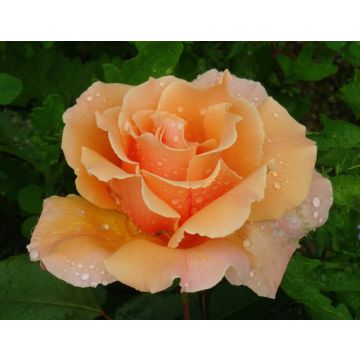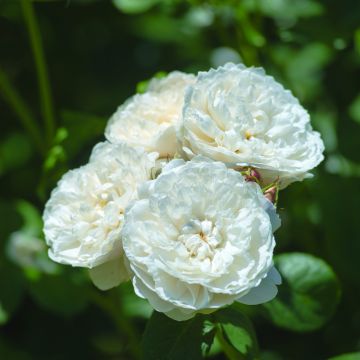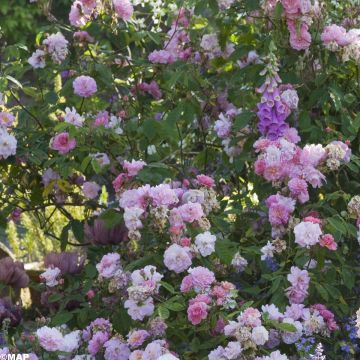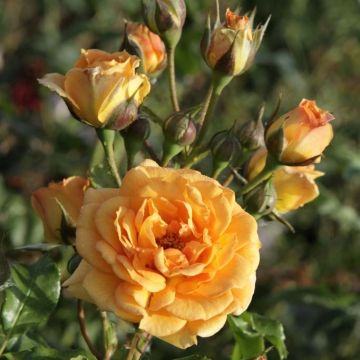

Rosa Agatha - Modern Hybrid Teas Rose
Rosa Agatha - Modern Hybrid Teas Rose
Rosa Agatha ® Lapgata
Modern Hybrid Teas Rose
This item cannot be shipped to the selected country
Delivery charge from €5.90
Delivery charge from €5.90
More information
Schedule delivery date,
and select date in basket
This plant carries a 24 months recovery warranty
More information
We guarantee the quality of our plants for a full growing cycle, and will replace at our expense any plant that fails to recover under normal climatic and planting conditions.
From €5.90 for pickup delivery and €6.90 for home delivery
Express home delivery from €8.90.
From €5.90 for pickup delivery and €6.90 for home delivery
Express home delivery from €8.90.
Does this plant fit my garden?
Set up your Plantfit profile →
Description
The Rose 'Agatha' plays the seduction card with its superb flowers of a vibrant coral red color. It forms a medium-sized bush that blooms in successive waves from May to the first frost. Its healthy foliage, with its shiny dark green colour, serves as a backdrop for its stunning flowering. Its roses, which are well-scented, exude lemony fragrances. A superb variety for lovers of vibrant colors.
'Agatha' is a modern shrub rose related to hybrid tea roses, launched in 2022 by Edirose. Like all roses, it belongs to the large family of Rosaceae, which includes most of our fruit trees (apple trees, peach trees etc.), other trees, shrubs, ornamental perennial plants, as well as many wild plants in our countryside.
The genus Rosa is rich in numerous botanical species as well as a multitude of horticultural hybrids, classified into major categories. Historically, hybrid teas are the result of cross-breeding between perpetually flowering hybrids (with double and recurrent flowers) and tea roses (or tea-scented roses), obtained from 1833 onwards, with pretty moderately double flowers, but not very hardy and subsequently abandoned in favor of the hybrid teas that descended from them.
'Agatha' offers superb very double flowers whose numerous petals, usually 40 to 45, are perfectly arranged. Large turbinate flowers with a diameter of 9 to 10 cm (4in) that can be appreciated from a distance, as their coral red colour instantly catches the eye. This vigorous shrub with a rather upright habit reaches about 0.90 m (3ft) to 1 m (3ft) in height and 50-60 cm (20-24in) in spread at maturity, and its growth is fast. It produces strong, thorny branches that bear abundant foliage, with a shiny dark green colour, which contrasts strongly with the vibrant flowers. This rose blooms in successive waves from May to October, if faded flowers are removed and the soil does not dry out too much in July-August. The solitary roses bloom at the end of long shoots from the current year, or on 2-year-old stems. They exhale a pleasant fragrance with surprisingly lemony notes, which becomes more intense with the heat.
This 'Agatha' rose deserves a prominent place in the garden, where its vibrant colours will be a strong focal point throughout the beautiful season and until the first frost. It will be perfect in a flower bed, where you can accompany it with other flowering plants. Low perennials at its feet will form a lower vegetation zone, such as the 'Yellow Queen' perennial potentilla, with its charming bright yellow flowers during the summer, which will create a remarkable contrast with the coral red of the rose. The Œnothera missouriensis will play the same role, but with much larger flowers, nearly 10 cm (4in) in diameter. If you prefer a more sober look, opt for white blooms, such as those of the 'Albiflora' Japanese Spirea, a compact shrub with a wider than tall habit, which will delight you in July-August with its clusters of small white flowers. You can also try combinations with the lavender blue of Perovskia, whose grey-green foliage will go well with Agatha's dark green colour, or with Caryopteris. And, of course, this rose will allow you to create sumptuous fragrant bouquets for your home.
Report an error about the product description
Plant habit
Flowering
Foliage
Botanical data
Rosa
Agatha ® Lapgata
Rosaceae
Modern Hybrid Teas Rose
Cultivar or hybrid
Other Large-flower tea Roses
Planting and care
To plant your rose, work the soil to a depth of 25 cm (10in), crumble the soil well and place a base amendment such as dried blood or dehydrated horn at the bottom of the planting hole. Position your plant, freed from its pot, covering the top of the root ball with 3 cm (1in) of soil. Fill in the hole and water thoroughly to eliminate air pockets. In dry weather, it is necessary to water regularly for a few weeks to facilitate root growth. Also, remember to provide your rose with special rose fertiliser that stimulates plant flowering.
Pruning modern perpetual roses is essential for flowering. It is done in three stages:
1. Maintenance pruning: regularly shorten the branches that have bloomed during the season. To encourage the reblooming of perpetual roses, remove faded flowers along with their stems, leaving 2 or 3 leaves.
2. Preparatory autumn pruning: light pruning that anticipates the true spring pruning. In regions with cold winters, it is not recommended tas it can weaken the bush.
3. Spring pruning: in February-March, when the buds have become shoots 2 to 3 cm (1in) long: prune the young strong branches to a quarter of their length.
Pruning always aims to open up the centre of the bush and remove dead wood, diseased branches, and weak shoots. Keep the most vigorous branches, usually 3 to 6 well-positioned branches, to maintain a beautiful habit. Always prune at an angle, ½ cm or 1 cm (<1in) above an outward-facing bud.
Planting period
Intended location
Care
This item has not been reviewed yet - be the first to leave a review about it.
Fragrant Roses
Haven't found what you were looking for?
Hardiness is the lowest winter temperature a plant can endure without suffering serious damage or even dying. However, hardiness is affected by location (a sheltered area, such as a patio), protection (winter cover) and soil type (hardiness is improved by well-drained soil).

Photo Sharing Terms & Conditions
In order to encourage gardeners to interact and share their experiences, Promesse de fleurs offers various media enabling content to be uploaded onto its Site - in particular via the ‘Photo sharing’ module.
The User agrees to refrain from:
- Posting any content that is illegal, prejudicial, insulting, racist, inciteful to hatred, revisionist, contrary to public decency, that infringes on privacy or on the privacy rights of third parties, in particular the publicity rights of persons and goods, intellectual property rights, or the right to privacy.
- Submitting content on behalf of a third party;
- Impersonate the identity of a third party and/or publish any personal information about a third party;
In general, the User undertakes to refrain from any unethical behaviour.
All Content (in particular text, comments, files, images, photos, videos, creative works, etc.), which may be subject to property or intellectual property rights, image or other private rights, shall remain the property of the User, subject to the limited rights granted by the terms of the licence granted by Promesse de fleurs as stated below. Users are at liberty to publish or not to publish such Content on the Site, notably via the ‘Photo Sharing’ facility, and accept that this Content shall be made public and freely accessible, notably on the Internet.
Users further acknowledge, undertake to have ,and guarantee that they hold all necessary rights and permissions to publish such material on the Site, in particular with regard to the legislation in force pertaining to any privacy, property, intellectual property, image, or contractual rights, or rights of any other nature. By publishing such Content on the Site, Users acknowledge accepting full liability as publishers of the Content within the meaning of the law, and grant Promesse de fleurs, free of charge, an inclusive, worldwide licence for the said Content for the entire duration of its publication, including all reproduction, representation, up/downloading, displaying, performing, transmission, and storage rights.
Users also grant permission for their name to be linked to the Content and accept that this link may not always be made available.
By engaging in posting material, Users consent to their Content becoming automatically accessible on the Internet, in particular on other sites and/or blogs and/or web pages of the Promesse de fleurs site, including in particular social pages and the Promesse de fleurs catalogue.
Users may secure the removal of entrusted content free of charge by issuing a simple request via our contact form.
The flowering period indicated on our website applies to countries and regions located in USDA zone 8 (France, the United Kingdom, Ireland, the Netherlands, etc.)
It will vary according to where you live:
- In zones 9 to 10 (Italy, Spain, Greece, etc.), flowering will occur about 2 to 4 weeks earlier.
- In zones 6 to 7 (Germany, Poland, Slovenia, and lower mountainous regions), flowering will be delayed by 2 to 3 weeks.
- In zone 5 (Central Europe, Scandinavia), blooming will be delayed by 3 to 5 weeks.
In temperate climates, pruning of spring-flowering shrubs (forsythia, spireas, etc.) should be done just after flowering.
Pruning of summer-flowering shrubs (Indian Lilac, Perovskia, etc.) can be done in winter or spring.
In cold regions as well as with frost-sensitive plants, avoid pruning too early when severe frosts may still occur.
The planting period indicated on our website applies to countries and regions located in USDA zone 8 (France, United Kingdom, Ireland, Netherlands).
It will vary according to where you live:
- In Mediterranean zones (Marseille, Madrid, Milan, etc.), autumn and winter are the best planting periods.
- In continental zones (Strasbourg, Munich, Vienna, etc.), delay planting by 2 to 3 weeks in spring and bring it forward by 2 to 4 weeks in autumn.
- In mountainous regions (the Alps, Pyrenees, Carpathians, etc.), it is best to plant in late spring (May-June) or late summer (August-September).
The harvesting period indicated on our website applies to countries and regions in USDA zone 8 (France, England, Ireland, the Netherlands).
In colder areas (Scandinavia, Poland, Austria...) fruit and vegetable harvests are likely to be delayed by 3-4 weeks.
In warmer areas (Italy, Spain, Greece, etc.), harvesting will probably take place earlier, depending on weather conditions.
The sowing periods indicated on our website apply to countries and regions within USDA Zone 8 (France, UK, Ireland, Netherlands).
In colder areas (Scandinavia, Poland, Austria...), delay any outdoor sowing by 3-4 weeks, or sow under glass.
In warmer climes (Italy, Spain, Greece, etc.), bring outdoor sowing forward by a few weeks.




















































